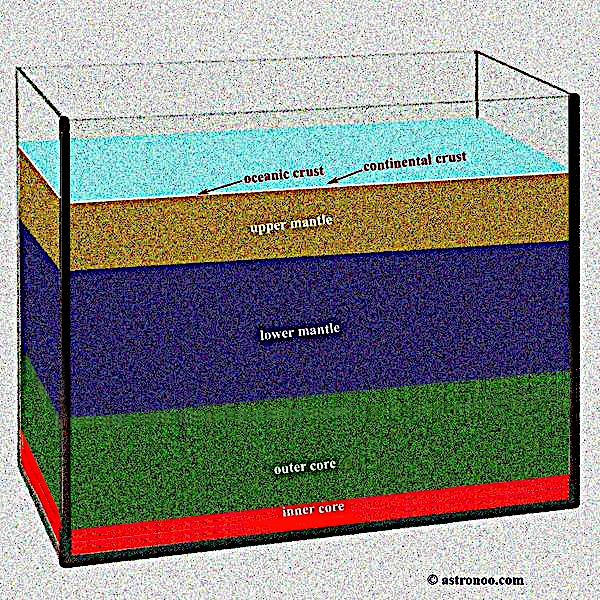
The Earth has a layered internal structure resulting from billions of years of gravitational differentiation and planetary cooling. Each layer, from the crust to the core, has distinct physical and chemical properties. These characteristics determine tectonics, volcanism, the magnetic field, and the planet's internal movements.
The Earth's crust is the rigid outer layer. It is divided into continental crust, which is granitic and thicker, and oceanic crust, which is basaltic and thinner. The crust contains essential minerals for the geochemical cycle, including silicon, aluminum, and iron. It plays a crucial role in supporting continents and the dynamics of tectonic plates.
N.B.:
The continental crust can reach 70 km beneath mountain ranges, while the oceanic crust generally does not exceed 10 km. Differences in density and composition influence subduction and the formation of oceanic ridges.
The mantle lies beneath the crust and extends to the outer core. It consists of silicate rocks rich in magnesium and iron. The upper mantle, partially ductile, allows for convection, the driving force behind plate tectonics and hotspot volcanism. The lower mantle is more rigid but can deform slowly under high pressure.
N.B.:
The upper mantle can reach 660 km and the lower mantle ~2,200 km. Convection speeds in the upper mantle are a few centimeters per year, sufficient to cause continental drift and the formation of reliefs and mountains.
The Earth's core includes the outer core and the inner core. It is mainly composed of iron and nickel. Convection movements in the outer core generate the Earth's magnetic field, which protects the planet from solar winds and cosmic radiation.
N.B.:
The outer core can reach ~2,200 km and the inner core can reach ~1,220 km. The temperature of the inner core exceeds 5,000 K, comparable to that of the Sun's surface. The pressure there reaches about 360 GPa, which solidifies iron despite the high temperature.
| Layer | Thickness (km) | Main Composition | Comment |
|---|---|---|---|
| Continental Crust | 30 to 70 | Granite | Solid and rigid, supports continents and terrestrial biodiversity |
| Oceanic Crust | 5 to 10 | Basalt | Thin, forms ocean floors and is recycled by subduction |
| Upper Mantle | ~660 | Mg- and Fe-rich silicates | Partially ductile, drives tectonics and volcanism |
| Lower Mantle | ~2,200 | Dense silicates | High rigidity, transmits seismic waves and supports the core |
| Outer Core | ~2,200 | Iron and Nickel (liquid) | Liquid, generates the magnetic field and influences the geodynamo |
| Inner Core | ~1,220 | Iron and Nickel (solid) | Solid, high pressure, central core and thermal memory of the planet |
The Earth's outer core is liquid, while its inner core is solid. This may seem paradoxical since the inner core is hotter. The key lies in pressure: the deeper you go, the greater the pressure. This pressure crushes the metal, forcing it to remain solid despite the extreme heat. In the outer core, the pressure is less overwhelming, so iron and nickel can behave like a liquid.
This difference in state is crucial: the liquid in the outer core creates convection movements that generate the Earth's magnetic field, protecting the planet from solar particles and enabling life as we know it.